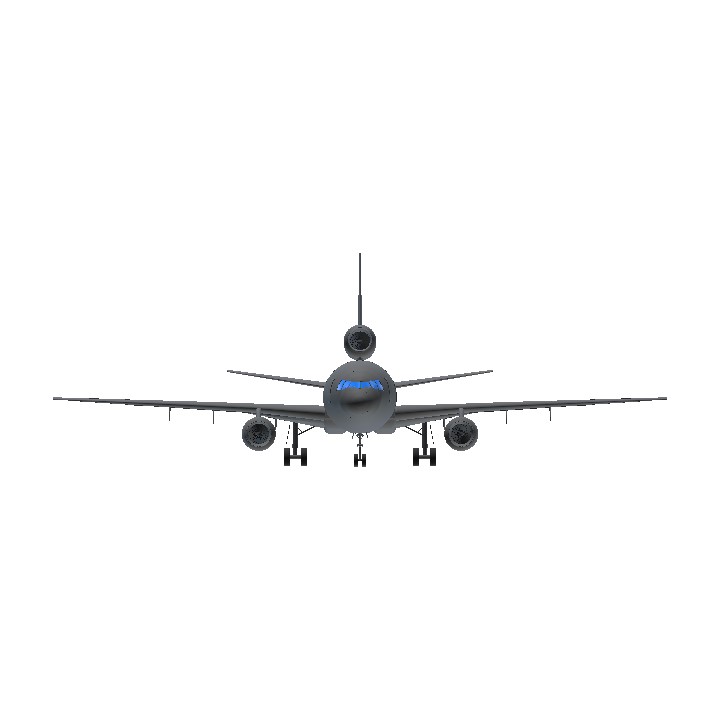Cool DC-10!
Pan Am Releasing soon... (totally not gonna take some time like GTA VI)
(Cockpit from MonikaAlterniyama)
Controls:
AG1 - Engine Startup
AG2 - Reverse Trust
AG3 - Burn Left Engine
AG4 - Burn Right Engine
AG5 - Burn Center Engine
AG6 to AG8 - N/A
Trim - Trim
Vtol - Flaps
WIKIPEDIA
The McDonnell Douglas DC-10 is an American trijet wide-body aircraft manufactured by McDonnell Douglas. The DC-10 was intended to succeed the DC-8 for long-range flights. It first flew on August 29, 1970; it was introduced on August 5, 1971, by American Airlines.
DC-10 / MD-10
The trijet has two turbofans on underwing pylons and a third one at the base of the vertical stabilizer. The twin-aisle layout has a typical seating for 270 in two classes. The initial DC-10-10 had a 3,500 nmi (6,500 km) range for transcontinental flights. The DC-10-15 had more powerful engines for hot and high airports. The DC-10-30 and -40 models (with a third main landing gear leg to support higher weights) each had intercontinental ranges of up to 5,200 nmi (9,600 km). The KC-10 Extender (based on the DC-10-30) is a tanker aircraft operated primarily by the United States Air Force.
Early operations of the DC-10 were afflicted by its poor safety record, which was partially attributable to a design flaw in the original cargo doors that caused multiple incidents, including fatalities. Following the American Airlines Flight 191 crash (the deadliest aviation accident in US history), the US Federal Aviation Administration (FAA) temporarily banned all DC-10s from U.S. airspace in June 1979. In August 1983, McDonnell Douglas announced that production would end due to a lack of orders, as it had a widespread public apprehension after the 1979 crash and a poor fuel economy reputation.[2] As design flaws were rectified and fleet hours increased, the DC-10 achieved a long-term safety record comparable to those of similar-era passenger jets.
Production ended in 1989, with 386 delivered to airlines along with 60 KC-10 tankers. The DC-10 outsold the similar Lockheed L-1011 TriStar. It was succeeded by the lengthened, heavier McDonnell Douglas MD-11. After merging with McDonnell Douglas in 1997, Boeing upgraded many in-service DC-10s as the MD-10 with a glass cockpit that eliminated the need for a flight engineer. In February 2014, the DC-10 made its last commercial passenger flight. Cargo airlines continue to operate a small number as freighters. The Orbis Flying Eye Hospital is a DC-10 adapted for eye surgery. A few DC-10s have been converted for aerial firefighting use. Some DC-10s are on display, while other retired aircraft are in storage.
Specifications
Spotlights
- AirFrance747400 1.4 years ago
- XProAerospaceAircrafts 1.4 years ago
General Characteristics
- Successors 4 airplane(s) +7 bonus
- Created On Android
- Wingspan 164.1ft (50.0m)
- Length 192.5ft (58.7m)
- Height 57.0ft (17.4m)
- Empty Weight 284,994lbs (129,271kg)
- Loaded Weight 316,846lbs (143,719kg)
Performance
- Power/Weight Ratio 0.5
- Wing Loading 48.3lbs/ft2 (235.9kg/m2)
- Wing Area 6,558.0ft2 (609.3m2)
- Drag Points 12835
Parts
- Number of Parts 660
- Control Surfaces 15
- Performance Cost 3,234





@Timothy19452022alternate Bird
@RolyBuilds
...What the Hell happened to the DC-10, did you get birds sucked into the engines?!
@Cryolophosaurus i can do it in the future
@Cryolophosaurus k
Please make an DC-9-15 or a dc-8-61
YOOO,IT HAS AN DETAILED COCKPIT!
Nice, although the windows don’t curve at the end